Apeldoorn
Apeldoorn (Dutch pronunciation: [ˈaːpəldoːrn] (![]()
Apeldoorn | |
|---|---|
City and Municipality | |
Former town hall in 2012 | |
 Flag  Coat of arms | |
.svg.png) Location in Gelderland | |
| Coordinates: 52°13′N 5°58′E | |
| Country | Netherlands |
| Province | Gelderland |
| Government | |
| • Body | Municipal council |
| • Mayor | Petra van Wingerden-Boers (acting) (VVD) |
| Area | |
| • Municipality | 341.15 km2 (131.72 sq mi) |
| • Land | 339.91 km2 (131.24 sq mi) |
| • Water | 1.24 km2 (0.48 sq mi) |
| Elevation | 16 m (52 ft) |
| Population | |
| • Municipality | 162,445 |
| • Density | 478/km2 (1,240/sq mi) |
| • Urban | 157,679 |
| • Metro | 213,899 |
| Demonyms | Apeldoornaar, Apeldoorner, Apeldorenaar |
| Time zone | UTC+1 (CET) |
| • Summer (DST) | UTC+2 (CEST) |
| Postcode | 3888, 7300–7381 |
| Area code | 055, 0577 |
| Website | www |
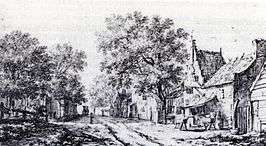
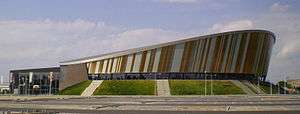
The town of Apeldoorn
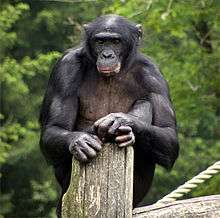
The oldest known reference to Apeldoorn, then called Appoldro, dates from the 8th century. The settlement came into being at the point where the old road from Amersfoort to Deventer crossed that from Arnhem to Zwolle. A 1740 map refers to it as Appeldoorn.[5]
Close by is the favourite country-seat of the royal family of the Netherlands called the palace het Nieuwe Loo (now Het Loo). It was originally a hunting lodge of the dukes of Gelderland, but in its present form dates chiefly from the time of the then Stadtholder William III of England (1685–1686).[5][6] The younger sister of Princess Beatrix, Princess Margriet, lives nearby the palace Het Loo, with her husband Pieter van Vollenhoven.
Apeldoorn was a relatively insignificant place until the major building projects of the 19th century and those of the period following World War II.[5] The Protestant church was restored after a fire in 1890.[6] The Roman Catholic Mariakerk is a national monument.
Apeldoorn possesses large paper-mills, many offices (Centraal Beheer, an insurance company; the Dutch Tax services; the "Kadaster", the government land registry service; and some more), a newspaper company, some hospitals and nursing homes. With over 95,000 people working in the municipality, Apeldoorn is one of the most important employment centres in the eastern Netherlands. Apeldoorn also has several important educational institutes, such as the Saxion University of Applied Sciences (hotel and facility management), the Wittenborg University of Applied Sciences, the Netherlands Police Academy and the Theological University of Apeldoorn.
In 2008 the largest paper mill of what was left of "Van Gelder Papier" after reorganizations went bankrupt, in 1996 a devastating fire destroyed the remnants of the last part of the original factory, other parts of the production facility that remained are now in use as production facility by AFP (Apeldoorn Flexible Packaging B.V.), Loparex B.V. and Owens Corning Veil Netherlands B.V. On the entire industrial estate now known as "Van Gelder Park" are now also located a local head office of Rabobank and it also houses the main police and fire department offices among with some other local companies like Futurumshop sporting goods, Akos engineering and Werklust load lifters, On the west side of this estate at the Laan van Westenenk there are still the buildings of one of the largest news printing companies of the region, Wegener, moved to this location in 1993, but they closed definitely in 2016 after reorganization, the buildings are now in use by other companies. Apeldoorn has been well known in the past as a town of paper making and clothing wash company's because of the clean filtered groundwater that seeps through the sand of the ice age formed (in Dutch)”stuwwallen” down to the “Ijselvallei” on the east of Apeldoorn.
Apeldoorn has also now a considerable meat processing industry with production and storage facilities of among others; Vion, Van Drie Group (ESA, Ekro), Grolleman Groep (cold stores, transport and meat processing), Amsterdam Meat Company (Ameco), other big/larger companies or ones that are of local importance are, among others; Hanos international (horesca), Hamer B.V. (installation), HSL Locistics but this will be as of January 2018 merged with GVT Logistics, Sandd (postal services), HCA Holland Colours (industrial plastics coloring), Remeha (heating boilers), Royal Reesink N.V., UPS, DHL, FedEx, Royal Talens (artist materials manufacturers and suppliers), VDL Weweler (international bus and truck parts manufacturing company), I.T.S. BV., Beekman transport, Kisjes transport and container rental, (others maybe added later).
Sandd postal services has been merged with PostNL, as a result of this the Sandd location in Apeldoorn will be closed indefinitely in the first week of February 2020, there has been some job losses, uncertain wat will happen to the location site.
In August 2018 PostNL opened a large package sorting center at the Oude Apeldoornseweg, newly build at the industrial area now known as “FizzionParc” but once was known as an industrial estate of Philips Data Systems, the new PostNL location will provide work for around 400 employees.
On November 27, 2018, a rapid spreading fire completely destroyed the largest store of “Karwei” DIY centers in The Netherlands, located at the Laan van de Dierenriem in Apeldoorn, no one was injured.
Apeldoorn is also known for its (historical) large number of used car dealers.
Apeldoorn had until a few years ago a production facility that produced basic materials for medicine production operated by Akzo Diosynth, but production was seized here, and the terrain located at the Vlijtseweg is now renamed after the product that was produced here before that, Zwitsal, it is now known as “Zwitsal Apeldoorn” and the former facility now houses many new local businesses such as the beer brewery “De Vlijt”.
Apenheul is a zoo which hosts a number of different types of apes and monkeys, some of which are free to walk around the visitors. It is situated at the western edge of Apeldoorn and can easily be reached by local bus 2, 3 and 5 (see Apeldoorn railway station, Bus Services). There is also an amusement park situated in Apeldoorn, called the Koningin Juliana Toren (Queen Juliana Tower). It is situated nearby the Apenheul and lies on the road to Hoog Soeren. It is called the Koningin Juliana Toren because of the tower, which was built in 1910 and was later named after Queen Juliana.
The local hospital is the Gelre Hospital "Lukas", offering secondary health care to Apeldoorn and the surrounding towns.
Apeldoorn railway station is, among regular national and international services, the terminus for the Veluwse Stoomtrein Maatschappij, a preserved steam railway that runs to Dieren via Beekbergen.
In April 2009 Apeldoorn made world news, when eight people were killed after a man tried to attack the Dutch royal family during a Queen's Day celebration by crashing his car near the royal family's bus.
The southwestern corner of the municipality is part of the Hoge Veluwe National Park. It is the final Battle Honour of The Royal Canadian Regiment who took part in the town's liberation in World War II.
House of Orange-Nassau
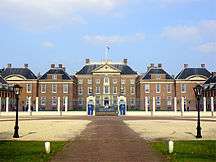
Paleis Het Loo reflects the historical ties between the House of Orange-Nassau and the Netherlands. The central part of the palace and the lateral pavilions show how the palace was inhabited by the House of Orange for three centuries starting with the King Stadtholder William III of England up to and including Queen Wilhelmina.
In November 1684 Prince William III of Orange, then Stadtholder of Gelderland, purchased Het Loo with the intentions of building a palatial hunting lodge somewhere on the property. On April 5, 1685, the first contract was tendered and in September of the same year the stonework of the middle section (or corps de logis) of what came to be known as Het Loo was completed. In 1686, the year given on the facade of the building, the wings, originally linked by colonnades to the corps de logis were added, the walls were built and the gardens were laid out.
Het Loo became the favorite hunting seat and country palace of William III and his wife Princess Mary II, and until his death in 1702 furnishings and decorations both inside and outside underwent repeated alterations and embellishments. At that time symmetry was considered ideal and the design for the building and grounds featured a central axis with mirror image components on either side. Inside the palace the axis consisted of the Entrance Hall, the Staircase and the Great Hall on the first floor. West and east of the Great Hall respectively were the apartments of William III and Mary II. The apartments of the courtiers and the Dining Room were on the ground floor.
In 1689 William III became King of England, Scotland and Ireland and this elevation of his position and power brought an enlargement of Het Loo in its wake. Between 1691 and 1694 the colonnades which linked the corps de logis to the wings on either side were replaced by four pavilions. These pavilions contained the new apartments of William III and Mary II, a new Dining Room, a Long Gallery and a Chapel. Queen Mary did not return to the Netherlands after 1689 and never saw the enlargement.
On the death of King William III in 1702 there was disagreement about his inheritance, but eventually, in 1732, Het Loo descended to Willem IV (1711–1751) who was, from 1747, Stadtholder of all the provinces. Both Willem IV and his son Willem V (1748–1806) used the palace in the 18th century as a summer residence.
Geography
Climate
Apeldoorn experiences an oceanic climate (Köppen climate classification Cfb) similar to almost all of the Netherlands.
| Climate data for Apeldoorn, 1981–2010 normals | |||||||||||||
|---|---|---|---|---|---|---|---|---|---|---|---|---|---|
| Month | Jan | Feb | Mar | Apr | May | Jun | Jul | Aug | Sep | Oct | Nov | Dec | Year |
| Average high °C (°F) | 4.3 (39.7) |
5.2 (41.4) |
8.5 (47.3) |
12.0 (53.6) |
17.0 (62.6) |
20.2 (68.4) |
21.3 (70.3) |
21.3 (70.3) |
18.8 (65.8) |
14.2 (57.6) |
8.5 (47.3) |
5.5 (41.9) |
13.1 (55.5) |
| Average low °C (°F) | −0.8 (30.6) |
−0.8 (30.6) |
1.7 (35.1) |
3.7 (38.7) |
7.5 (45.5) |
10.4 (50.7) |
12.1 (53.8) |
12.0 (53.6) |
9.8 (49.6) |
6.7 (44.1) |
3.1 (37.6) |
0.6 (33.1) |
5.5 (41.9) |
| Average precipitation mm (inches) | 66.0 (2.60) |
48.0 (1.89) |
54.0 (2.13) |
48.0 (1.89) |
58.0 (2.28) |
69.0 (2.72) |
77.0 (3.03) |
76.0 (2.99) |
69.0 (2.72) |
66.0 (2.60) |
73.0 (2.87) |
74.0 (2.91) |
778 (30.63) |
| Average precipitation days (≥ 0.1 mm) | 13 | 9 | 12 | 9 | 10 | 11 | 9 | 9 | 11 | 12 | 13 | 13 | 131 |
| Average relative humidity (%) | 88 | 84 | 81 | 75 | 74 | 75 | 76 | 77 | 82 | 86 | 89 | 90 | 82 |
| Source: [7] | |||||||||||||
Population centres
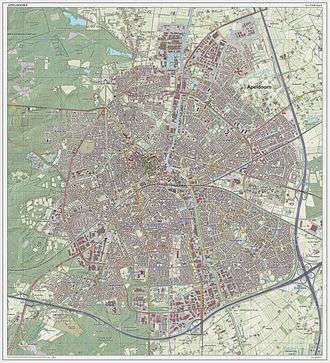
Very small hamlets are printed in italics.
- Apeldoorn (see below)
- Assel
- Beekbergen: a village 6 km south of Apeldoorn
- Beemte-Broekland, north of Apeldoorn
- Engeland, west of Beekbergen
- Groenendaal, along the A50 motorway Apeldoorn - Arnhem
- Hoenderloo, 8 km south-west of Apeldoorn, along the road to Ede, near the Hoge Veluwe National Park
- Hoog Soeren, situated amidst the Veluwe forest
- Hooilanden
- Klarenbeek, east of Lieren, partially in the municipality of Voorst
- Lieren
- Loenen, this village, 5 km south-east of Beekbergen, has a castle ("Ter Horst"), a cardboard factory and an artificial "waterfall"
- Nieuw-Milligen, about 10 km in the direction of Amersfoort, consists of an army training centre, some camping sites and some scattered houses and farms
- Oosterhuizen
- Radio Kootwijk
- Uddel, a farmer's village 10 km north-west of Apeldoorn, where pigs and calves are raised; the majority of its population is known to belong to very orthodox Protestant Churches
- Ugchelen, formerly a village of its own, now an outer area of Apeldoorn, still having its own character
- Wenum-Wiesel, with an old water-mill; situated 5 km north of Apeldoorn
- Woudhuizen, now at the eastern border of Apeldoorn. There is an outer area in Apeldoorn called "Woudhuis" and there is a small forest, called "Woudhuizer Bos"
- Zilven, the northern edge of Loenen
Economy and infrastructure
Local businesses
- Centraal Beheer, a Dutch insurance company, known for their advertisement slogan Even Apeldoorn bellen (Just call Apeldoorn)
- Sparta B.V., a Dutch bicycle manufacturer based in Apeldoorn
- Royal Talens, now multinational manufacturer of painter's colours
Transport
There are four railway stations in Apeldoorn, these are:
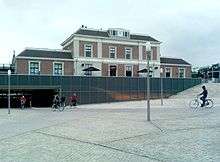 Central station Apeldoorn |
Station Apeldoorn De Maten |
Station Apeldoorn Osseveld |
.jpg) Station Klarenbeek |
The bus services in the city are provided by Syntus and has 18 lines.
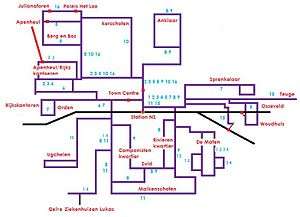 A Map Of The Stadbus Plus Network |
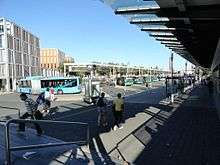 Apeldoorn Bus station |
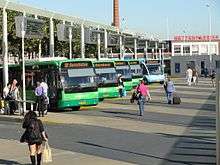 Apeldoorn Bus station |
Culture
Sport
Until early 2013, Apeldoorn housed the professional football club AGOVV Apeldoorn (Eerste Divisie), that played its matches in the Sportpark Berg & Bos stadium in the western part of Apeldoorn. However, AGOVV was forced to declare bankruptcy on January 10, 2013, because of an €400,000 tax debt. In 1958 the AGOVV stadium was used to promote Dutch Rugby Football, by staging a match between an English touring XV Thomas Cook's Rugby Club and RC Hilversum in front of 2,671 spectators. It was a 3 points draw. See film clip of first overseas tour to Holland 1958 [8] The present rugby club, Rams RFC, was founded in December 1971.
The most successful club in Apeldoorn is the SV Dynamo volleyball team, who are the 12-fold champion in the Dutch A-League, most recently in 2010. Another successful volleyball club in Apeldoorn, and a big competitor to Dynamo, is Alterno.
Because of the growth of Apeldoorn, and the population's interest in sports, Apeldoorn has built a new stadium for volleyball, indoor athletics and track cycling. The stadium, Omnisport Apeldoorn, opened in 2008 and has hosted the 2011 UCI Track Cycling World Championships and the European Track Championships in 2011 and 2013. In 2016 the city hosted the opening time-trial stage of the Giro d'Italia.
Apeldoorn houses the following football clubs:
- AGOVV
- Alexandria
- Apeldoornse Boys
- Columbia
- CSV Apeldoorn
- Groen−Wit '62
- Orderbos
- Robur et Velocitas
- Turkse Kracht Apeldoorn
- Victoria boys
- WSV
- ZVV '56
Notable people

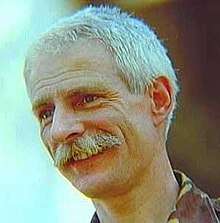
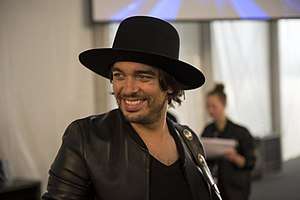
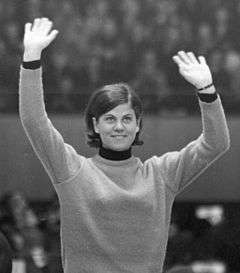
Public servants
- Piet de Jong (1915–2016) a Dutch politician and Prime Minister of the Netherlands 1967/1971
- Willem van Zeist (1924–2016) a Dutch archaeobotanist and palynologist
- Arend Lijphart (born 1936) a political scientist
- Pieter van Vollenhoven Jr. (born 1939) the husband of Princess Margriet of the Netherlands
- Hanja Maij-Weggen (born 1943) a retired Dutch politician
- Willem Ouweneel (born 1944) a Dutch biologist, philosopher and theologian
- Jacques Wallage (born 1946) a retired Dutch politician
- Colonel Thom Karremans (born 1948) the commander of Dutchbat troops in Srebrenica
- Fred de Graaf (born 1950) a retired Dutch politician, Mayor of Apeldoorn 1999/2011
- Mart de Kruif (born 1958) a three-star general in the Royal Netherlands Army and its executive commander.
- Marit Maij (born 1972) a Dutch politician, former management consultant, diplomat and civil servant
The arts
- Patrick Bakker (1910–1932) a Dutch artist in oil paintings, pen and pastel drawings
- Berend Hendriks (1918–1997) a Dutch artist, co-founded the Arnhem school of environmental art
- Edgar Burcksen (born 1947) a Dutch film editor [9]
- Emile Jansen (born 1959) a Dutch TV, film and theatre actor [10]
- Jeroen Jongeleen (born 1967) a Dutch artist
- Willem Bijkerk (born 1980) known professionally as Waylon is a Dutch singer
- Julian Jordan (born 1995) a Dutch DJ, record producer and musician
Sport
- Nico de Wolf (1887–1967) a Dutch amateur footballer, bronze medallist in the 1912 Summer Olympics
- Ans Schut (born 1944) a former ice speed skater, gold medallist at the 1968 Winter Olympics
- Edward Sturing (born 1963) a Dutch former footballer with 452 caps
- Peter Bosz (born 1963) a Dutch former footballer, current manager of Bayer Leverkusen
- Mark Schenning (born 1970) a former Dutch professional footballer with 436 caps
- Corine Dorland (born 1973) a Dutch amateur BMX racer from 1981 to 1996
- Demy de Zeeuw (born 1983) a retired Dutch footballer with 306 caps
- Steven Berghuis (born 1991) a Dutch professional footballer
Business
- Marc Bolland (born 1959) a Dutch businessman, who was the CEO of Marks & Spencer and CEO of Morrisons
2009 car attack
On April 30, 2009, the Dutch national holiday Koninginnedag (Queen's Day), a man drove his car at high speed into a parade which included Queen Beatrix and other members of the Royal family.[11]
The driver hit members of the public lining the street leaving twenty-two injured and eight dead, including the driver himself, who died the following day. Although the Royal family was unharmed, it is believed to be the first attack on the Dutch royal family in modern times.[12]
Sister Cities
References
Citations
- "Kerncijfers wijken en buurten" [Key figures for neighbourhoods]. CBS Statline (in Dutch). CBS. 2 July 2013. Retrieved 12 March 2014.
- "Postcodetool for 7311LG". Actueel Hoogtebestand Nederland (in Dutch). Het Waterschapshuis. Retrieved 11 June 2014.
- "Bevolkingsontwikkeling; regio per maand" [Population growth; regions per month]. CBS Statline (in Dutch). CBS. 1 January 2019. Retrieved 1 January 2019.
- "Bevolkingsontwikkeling; regio per maand" [Population growth; regions per month]. CBS Statline (in Dutch). CBS. 26 June 2014. Retrieved 24 July 2014.
- Stenvert, R. et al. (2000). Monumenten in Nederland: Gelderland, p. 14 and 68–77. Zwolle: Waanders Uitgevers. ISBN 90-400-9406-3
-

- "Archived copy". Archived from the original on 2015-04-02. Retrieved 2015-03-08.CS1 maint: archived copy as title (link)
- 1958 News clip- 'Rugby Apeldoorn' : https://www.facebook.com/john.dann/videos/1419242911462176/
- IMDb Database retrieved 31 July 2019
- IMDb Database retrieved 31 July 2019
- "Car attack on Dutch royal parade". BBC News. 30 April 2009.
- "RTL News broadcast". 30 April 2009. Archived from the original on 2009-05-01.
- "Sister City". Archived from the original on 2013-12-14.
- "Sister City".
Sources
- CBC Archives – CBC Radio (April 22, 1945) reporting on the famine in Apeldoorn and the inflation of food prices.
External links
| Wikimedia Commons has media related to Apeldoorn. |
- Official website (in Dutch)

